When My World Was Young...
1945 - 1956
I
was born in a rural village on the banks of the................uh, I guess we
don't have to start that far back.
However, it does matter that I was an extremely precocious reader as a child. It was this ability which gave me some glimpses into another - secret - world. And these glimpses, though I was often confused or even thunderstruck by them, were far clearer than those being afforded by my own emerging sense of the erotic, which was in itself something altogether puzzling and a bit scary.
My fantasy of "the man on the rock"
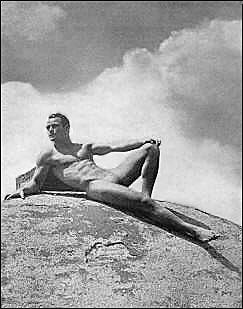
Late in the Forties, when I would have been around ten years old, I started reading a book I picked out of my aunt's bookcase. It had looked to be an adventure story about a man's journey from the Middle East to China. What that adventure might be about never became clear to me, and I continued reading only because of the descriptions of exotic places. The rest of it seemed to be sort of about that "love" stuff that grownups were wound up in - and so damned tightlipped about. Then something else came up. It seemed an awful lot like the love stuff too, but it was about another man, and having close to zero idea what that love stuff between men and women was all about, this really was a case of absolute zero. Nothing much seemed to happen in any event, though I was awfully intrigued by the description of the other guy lying naked on a rock, sunning himself - so intrigued that I kept going back to reread the passage. In the end things didn’t get any clearer...but I did like the book...and the picture in my mind of that man on the rock. The book was The Asiatics by Frederic Prokosch. Prokosch, as I was to learn much, much later from a friend of his was gay. He managed to work a veiled homosexuality into many of his books, adroitly camouflaged by his rather ornate writing style and a general penchant for exotica and ambiguity.
About this time I began to have the usual homosexual fumblings with grade school friends. My peepee was becoming a prick. I also made sneaking forays into that section of the library where the forbidden adult arcana was stashed. The finds were stunning. Now I had a "penis"! Unfortunately the jargon in these books was so esoteric that the mechanics of the fuck really eluded me. However, I did get the picture that "love" stuff was a lot of wrapping paper around "sex" stuff. And I did get that some men did this stuff with other men. They were "homosexuals" or "inverts," and this was not good sex stuff. Not a happy discovery as I was quite liking it by this time.
During the summer between sixth grade and the beginning of junior high school, an older classmate gave me what could quite appropriately be described as a cram course in sex, as it moved from “playing doctor” to penetration. WW II, food rationing
 My discovery that there was an actual subculture of
homosexuals - although I wouldn't have known what that meant at the time -
occurred not much later. I was visiting some relatives and was bored listening
to them talk, so I began to leaf through my uncle's magazines. One of them was
Esquire. There wasn't much of anything in it for me, in most cases
the articles were about topics I hardly grasped. Something caught my eye,
and I began to read an article. It may have been about New York City in general or
perhaps about its "low
life", I can't remember. But at one point the article it began
describing a group of bars called the Bird Circuit. Their nickname came from
the fact that they all had a bird motif in their names, i.e. - Blue Parrot,
etc. These were places where homosexual men met and socialized. Oh my gawd, and
right there in a magazine too! I closed it immediately, afraid that someone
might ask me what I was reading.
This was my first indication that homosexuality had a
dimension larger than that of an erect penis. Although I learned nothing more
about homosexual social life for years, I never forgot that first glimpse in
Esquire magazine.
My discovery that there was an actual subculture of
homosexuals - although I wouldn't have known what that meant at the time -
occurred not much later. I was visiting some relatives and was bored listening
to them talk, so I began to leaf through my uncle's magazines. One of them was
Esquire. There wasn't much of anything in it for me, in most cases
the articles were about topics I hardly grasped. Something caught my eye,
and I began to read an article. It may have been about New York City in general or
perhaps about its "low
life", I can't remember. But at one point the article it began
describing a group of bars called the Bird Circuit. Their nickname came from
the fact that they all had a bird motif in their names, i.e. - Blue Parrot,
etc. These were places where homosexual men met and socialized. Oh my gawd, and
right there in a magazine too! I closed it immediately, afraid that someone
might ask me what I was reading.
This was my first indication that homosexuality had a
dimension larger than that of an erect penis. Although I learned nothing more
about homosexual social life for years, I never forgot that first glimpse in
Esquire magazine.
'44, bobby soxers in a record store
 My parents had married in the early 30's after knowing
each other just six weeks - he was 18, she was 19. Both came from families of
Irish origin. However, my mother, whose family were generations of
staunchly anti-Catholic members of the Orange Order and dedicated Presbyterians, converted to my father's Catholic faith - despite
the fact that my father did not attend church! A daughter born a few years
after their marriage was severely deformed and died shortly after her first
birthday. My father did heavy manual labor for a living, and they/we were to
live in a state of ongoing financial insecurity until the post-WW II years.
During the war my father was exempt from active duty because his job was
deemed vital to the war effort.
My parents had married in the early 30's after knowing
each other just six weeks - he was 18, she was 19. Both came from families of
Irish origin. However, my mother, whose family were generations of
staunchly anti-Catholic members of the Orange Order and dedicated Presbyterians, converted to my father's Catholic faith - despite
the fact that my father did not attend church! A daughter born a few years
after their marriage was severely deformed and died shortly after her first
birthday. My father did heavy manual labor for a living, and they/we were to
live in a state of ongoing financial insecurity until the post-WW II years.
During the war my father was exempt from active duty because his job was
deemed vital to the war effort.
As long as I could remember he worked literally from dawn to dusk (6 a.m. to 6 p.m.) and sometimes longer, seven days a week, three hundred and sixty-five days a year. His only days off are when he is hospitalized. My mother went on secret spending binges for clothes, causing bills to accumulate. The rent is often late, sometimes we run out of credit at the grocery store. I go to a public school, but I enjoy the Christian Doctrine classes we Catholics attend (during "released time" from public school) once a week at the tiny clapboard parochial school.
1942 war propaganda poster
August 1945: I've just turned seven. Everyone rushes down to Main Street for a spontaneous celebration on V-J Day (the surrender of Japan.) People are packed on the sidewalks and hanging out of windows, laughing and crying; the school band has gotten its instruments and is leading a rag-tag parade, some people are on foot while others are standing and sitting on the tops of slow-moving cars, throwing shredded waste paper and streamers of toilet paper in lieu of confetti and crepe paper. It is exciting, but the unbridled craziness - like nothing I've ever seen from grownups - is a little frightening. I understand that the Honor Roll in front of the Village Hall will not get any more names, and the curfews and blackouts won't happen again, but I grew up with the other neighborhood kids playing "war," seeing movies about "the war", collecting scrap metal for "the war," picking milkweed pods to be used in "the war," using ration books for food because of "the war"......"the war" has always been there in my life. What comes after "the war?"
THE POST-WAR FORTIES: BACK TO THE THIRTIES?
* The first
meeting of the United Nations organization takes place in an effort to build a
forum for the peaceful solution of world
problems out of the WW II anti-Axis alliance. Already, however, the Soviet
Union is backing away from its wartime partners, and in the speech at a college
in Fulton, Mo. Winston
Churchill declares that an "Iron Curtain" had fallen across Europe, he also
tells his American audience:
"In a great number of countries, far from the Russian frontiers and throughout the world, Communist fifth columns are established and work in complete unity and absolute obedience to the directions they receive from the Communist center."
The Cold War is now official. And Americans will soon be caught up in the spectacle of their politicians and government attempting to ferret out supposed hordes of hidden Communist agents.
(right) Churchill's "Iron Curtain" speech, Pres. Truman in background.
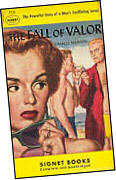 * Charles Jackson, author of best selling
The
Lost Weekend, a breakthrough novel about alcoholism, writes The Fall of
Valor - a book about a middle-aged man's discovery of his homosexuality.
Booze, yes, the critics say; homos, no. And so much for his career.
* Charles Jackson, author of best selling
The
Lost Weekend, a breakthrough novel about alcoholism, writes The Fall of
Valor - a book about a middle-aged man's discovery of his homosexuality.
Booze, yes, the critics say; homos, no. And so much for his career.
1949 paperback
The Lost Weekend had been made into an award-winning film in 1945, but the studio changed the source of the protagonist's problem drinking from the accusation that he had an affair with a male friend in college (as in the book) to frustration over of a case of writer's block. Jackson would commit suicide in New York's Chelsea Hotel in 1968.
1947
* The Soviet Union begins a blockade of the Western Allies' part of Berlin that lasts for two years, forcing the Berlin airlift by the Allies to supply their sectors of the city with all the food, fuel and supplies needed to sustain the life of its citizens and the Western occupation forces.
* The House Un-American Activities
Committee (HUAC),
created during the Red Scare
of the Thirties, is revived. Ronald Reagan and
Walt Disney, among
 other Hollywood figures, testify as "friendly witnesses," and Ayn Rand also testifies to pro-communism in the film industry. Reagan,
continued to be a pipeline for confirming or denying the Communist associations
of Hollywood figures. Those who refuse to testify are blacklisted and their
careers are destroyed, some receive prison sentences.
other Hollywood figures, testify as "friendly witnesses," and Ayn Rand also testifies to pro-communism in the film industry. Reagan,
continued to be a pipeline for confirming or denying the Communist associations
of Hollywood figures. Those who refuse to testify are blacklisted and their
careers are destroyed, some receive prison sentences.
* Alger Hiss (photo right), a high-ranking State Department member, is indicted for perjury in regard to his activities on behalf of the Soviet Union.
* The armed services "Blue Discharge" (neither honorable nor dishonorable) given to homosexuals up until now is changed to a mandatory Dishonorable Discharge. Kick them faggots' asses, Uncle Sam!
* Billie Graham holds tent crusade in Los Angeles; Hearst orders his papers to provide favorable coverage.
Elizabeth Short: The Black Dahlia. February '48 issue
* The lurid Black Dahlia murder case, in which a young would-be movie actress turned party girl is savagely tortured and eviscerated, fascinates readers across the nation. Americans have a voracious appetite for stories about sex and violence, providing an appropriate "moral" is tacked onto them as an excuse for the titillation they provide. (The case remains unsolved.)
* Jackie Robinson becomes the first black professional baseball player. He faces the abuse of fellow players and fans alike with great dignity, and the white face of the national leagues begins to change.
*  Ingrid Bergman
(photo right), who has risen to the heights
of movie stardom with Casablanca and Notorious, is awarded a Tony for
her performance in Joan of Lorraine in the first annual presentation of the
awards. However, a little over a year later, while working on a film in Italy,
she has an extra-marital affair which results in the birth of an illegitimate
son. She is denounced on the floor of U.S. Senate as "Hollywood's apostle of
degradation" and the senator declares that she will never be allowed to set foot
on American soil again. Her film career in the U.S. goes on ice.
Ingrid Bergman
(photo right), who has risen to the heights
of movie stardom with Casablanca and Notorious, is awarded a Tony for
her performance in Joan of Lorraine in the first annual presentation of the
awards. However, a little over a year later, while working on a film in Italy,
she has an extra-marital affair which results in the birth of an illegitimate
son. She is denounced on the floor of U.S. Senate as "Hollywood's apostle of
degradation" and the senator declares that she will never be allowed to set foot
on American soil again. Her film career in the U.S. goes on ice.
1948
 *
All three major networks are busy linking their individual TV broadcasting
stations into integrated telecasting networks. The Howdy Doody Show is now a nationwide
children's show. The Peanut Gallery (the onstage audience of youngsters)
contains no black faces. Ed Sullivan and Perry Como are beginning what were to
become incredibly long-running shows. Later Como would bridle at the network
codes governing how whites and blacks could physically interact with each other
on camera and without fanfare break those taboos. He was be too popular to be
slapped down.
*
All three major networks are busy linking their individual TV broadcasting
stations into integrated telecasting networks. The Howdy Doody Show is now a nationwide
children's show. The Peanut Gallery (the onstage audience of youngsters)
contains no black faces. Ed Sullivan and Perry Como are beginning what were to
become incredibly long-running shows. Later Como would bridle at the network
codes governing how whites and blacks could physically interact with each other
on camera and without fanfare break those taboos. He was be too popular to be
slapped down.
* Dr. Alfred Kinsey's book, Sexuality in the Human Male, shocks Americans. Its report of a high incidence of homosexual behavior and orientation is especially repugnant. Its research and comments on homosexuality continue to be some of the most misunderstood and misused material on the subject by both gay people and their adversaries for the next half century.
*
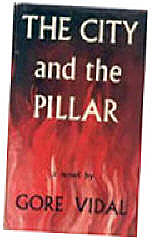 And within a few days of the Kinsey Report, heralded new young writer, Gore
Vidal, publishes The City and the Pillar. Written in blunt, pulp prose
it is a novel with an undisguised gay male protagonist and set in the
contemporary homosexual subculture. The very homophobic daily New York Times
refuses to review
his next five books, and Vidal always insisted that his fiction career took a
major hit because of this novel. Any set-back, in fact, was only short
term, as
he would steadily become America's most well-known and brilliant gay public
figure in the second half of the 20th century -- novelist, playwright,
politician, essayist and social commentator.
Almost three decades later the
Times began to cautiously and unevenly ease up on its homophobic policies.
And within a few days of the Kinsey Report, heralded new young writer, Gore
Vidal, publishes The City and the Pillar. Written in blunt, pulp prose
it is a novel with an undisguised gay male protagonist and set in the
contemporary homosexual subculture. The very homophobic daily New York Times
refuses to review
his next five books, and Vidal always insisted that his fiction career took a
major hit because of this novel. Any set-back, in fact, was only short
term, as
he would steadily become America's most well-known and brilliant gay public
figure in the second half of the 20th century -- novelist, playwright,
politician, essayist and social commentator.
Almost three decades later the
Times began to cautiously and unevenly ease up on its homophobic policies.
Gore Vidal put a knot in
the shorts of
most American
reviewers, and a crimp
in his career, with
his third book.
*
Within weeks of these two juicy morsels, straight reviewers had to deal with
Truman Capote's precious bon-bon of a novel, Other Voices, Other Rooms.
It is perhaps as much a misty fairy tale as a gay novel. Loaded with
Deep South atmosphere, much lovely writing and swampy passages of florid,
purple prose, unlike Vidal's novel it tends more to suggest and hint its
homosexuality. It fared better with the critics, but when pressed by
Capote, editor George Davis replied,
"I
suppose someone had to write the fairy
Huckleberry Finn."
1949
* The Union of South Africa begins
the official
implementation of the Apartheid system,
which classifies all citizens by race
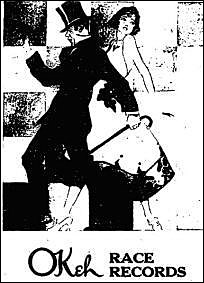 and keeps them rigidly separated. Disapproving articles appear in American
magazines. This despite the fact that in the U.S. - contrary to later
impressions - laws mandating some form of racial segregation are in force in twenty-one
states, only eleven of these are in the Deep South. The
definition of a "Negro" in the state of Mississippi is anyone with "one drop" of
Negro
blood.
and keeps them rigidly separated. Disapproving articles appear in American
magazines. This despite the fact that in the U.S. - contrary to later
impressions - laws mandating some form of racial segregation are in force in twenty-one
states, only eleven of these are in the Deep South. The
definition of a "Negro" in the state of Mississippi is anyone with "one drop" of
Negro
blood.
(left) "Colored" drinking fountain: Almost 50 % of the U.S. states have some form of legal segregation - rigid separation of all public facilities and amenities is the law in at least half of these states. A bit of folk wisdom in doggerel form said: If you're black, stay back; if you're brown, keep down; if you're white, you're alright.
(right) "Race music" is recorded on independent and specialty labels specifically created to produce "race music." Most "race records" are distributed only in black neighborhoods.* Billboard magazine, the weekly bible of the music industry, ceases using the term "race music" to describe record sales charts of music by black artists intended for the "Negro" market. It substitutes the term Rhythm & Blues coined by white reporter Jerry Wexler, who thought "race music" was offensive. In the Fifties Wexler would join Atlantic Records and in the 60's, as a musical producer, he recorded Wilson Pickett, Aretha Franklin and other black artists. He was a major figure in bringing "soul music" into the American pop music mainstream.
*
Kukla, Fran & Ollie, supposedly a
children's puppet show, moves to an adult time slot to accommodate its huge adult
audience. The dialogue is improvised, sophisticated, filled with double
entendres and flagrantly campy. Thank you Burr Tillstrom! Eleven
years old, and the subversion of camp was
 getting
through. My mother says, "I don't know how kids understand this."
Did she?
getting
through. My mother says, "I don't know how kids understand this."
Did she?
* Frozen foods and packaged "mixes" are appearing as standard items in food stores.
* The weird looking 45 rpm record makes its debut. Made of something called vinyl and thin and shiny with a big fat hole that couldn't be accommodated by existing record players, what was this supposed to be? But it was virtually unbreakable, much more convenient to store and cheaper to make, and the brains behind this little beast knew exactly where they were tossing it - kids. It was a time bomb: and it had a very short fuse.
* George Orwell's 1984 is published. (OK, so he was a little more than 30 years off.)
* Bitter Rice, an Italian film about female migrant workers opens. Critics
like it, but a battery of moral guardians fulminates in outrage. Curious
Americans used to Hollywood fare that sentimentalized, and consequently
trivialized, the tragic aspects of life, form long lines at the box office for a
taste of verismo. The poster featuring a large image of the bosomy star in a
defiant pose, standing in the water and clad in a very tight blouse and short
shorts, was assumed to explain the unusual number of male patrons. Silvana
Mangano gave an earthy, sensuous performance and the rice field scenes were
realistic enough for a documentary. Bitter Rice was a harbinger of the wave of
foreign films that would play to general audiences rather than art theaters.
Bitter Rice poster with Silvana Mangano
* Lost Boundaries, a movie depicting a "Negro" family that passes for white opens. It is a critical success, but it makes white audiences uncomfortable, and theatres in the South refuse to show it. The story is drawn from the life of a real New Hampshire family. As with the novel Quatrefoil, Post-Modern critics later lambasted the film as timid, conveniently forgetting that in this era the making of it risked the careers of many people and that the film crew was responsible for breaking racist public accommodations barriers in the state of New Hampshire.
* Late
in the Forties my parents buy a dilapidated house with no heating, and we leave
the neighborhood where I have grown up. Despite the fact the war is over, my
father keeps his same Trojan work schedule; even as he becomes successful and
can hire people to work for him he spends his increasing free time down on Main
Street. By this time I am painfully aware that my parents have a wretched
marriage, and our three-way relationship is rarely free of suffocating
tension and frustration.
By the end of the decade America's three great post-war struggles are already well-defined: The Cold War abroad and the Red Scare at home, the battle over legislated segregation and racism, and the struggle to maintain the conservative sexual and social standards of the previous decades despite the profound dislocations of the war years.
But many things were reassuringly the same. The children's matinees still features the old cowboy standbys of Roy Rogers and Hopalong Cassidy, and Gene Autry is back from the army and turning out westerns again too. Johnny Weismuller is still Tarzan, but his increasingly porky physique turns the ex-swimming star's once spectacular dives into something more like belly-whoppers. On the roster of Oscar nominees in the post-war Forties are the familiar pre-war names of Ronald Coleman, Loretta Young, Jane Wyman, William Holden...and that perennial portrayer of "molls, floozies and broads," Claire Trevor, whose 1948 performance in Key Largo, playing opposite a magnificent Edward G. Robinson (above), steals center stage from the wooden performances of stars, Lauren Bacall and Humphry Bogart.
Your Hit Parade radio show appeals as much to parents as their adolescent children. The Bobby Soxer image of the adolescent is alive and well - and not a negative one. If Hit Parade type music seems caught in a time warp, jazz is not. While mainstream Big Band music is rapidly dying out, small jazz combos and various solo artists are vibrant and innovative (if not yet mainstream) - Charley Parker and Bebop (music) are the cutting edge. West 52nd Street in Manhattan (above) is still lined with jazz joints, and other cities across the nation have their jazz strips too. And across the South, the segregated blacks-only "Chiltin' Circuit" of venues, promoters and new performers is a birthing ground for these post WWII changes in jazz and the oncoming juggernaut of Rhythm 'n' Blues. It's not Benny Goodman, however. And the world of jazz clubs is regarded with suspicion by many middle class whites who associate it with "dope," loose morals, etc. - and not least of all the "Negro" and casual attitudes toward "race mixing." The even rawer and gutsier world of popular "race music" is simply unknown.
The world of the black American is kept at a distance by most whites no matter how close it might be as a physical fact - blacks are seen as comical, stupid and clumsily well-intentioned, yet powerfully sexual and violent. And in the end, they were almost always seen in terms of a problem.Robert Duncan: "[my] deepest social feelings were irregular...
for I saw the State and the War as a disease."
By the end of the war thousands of gay men and lesbians have received Blue Discharges, and many are dumped unceremoniously in U.S. port cities after being brought back from abroad. It has been frequently suggested that this had the effect of concentrating gay populations in New York and San Francisco. In 1944 gay poet Robert Duncan had published The Homosexual in Society. (He had received a discharge from the army for being gay.) While neither he nor his essay became household words, even for gay people, it should be remembered that Duncan and other gay poets were leading figures among what are known as the San Francisco and the New York poets, as well in the Beat Generation. Their overtly gay poetry is a major part of the small amount of what would now be termed
"out" artistic works in those dangerous times.
In 1945 Bob Mizer (right) and two others started the Athletic Model Guild, the vanguard for the male homoerotic magazines which were to become a characteristic element of the 1950's gay male world.
The homosexual is so odious (and usually hidden ) that he - but, God forbid! certainly not she - rarely has an openly acknowledged place in the American mind. Guy Gabrielson, Republican National Committee Chairman, would declare in the following year, "Perhaps as dangerous as the actual Communists are the sexual perverts who have infiltrated our Government in recent years...The country would be more aroused over this tragic angle of the situation if it were not for the difficulties of the newspapers and radio commentators in adequately presenting the facts, while respecting the decency of the American people." Alas! Nevertheless, the almost unspeakable Lavender Scare joins the Red Scare as a peril to the American Republic.
In terms of the gay history of New York City the landmark gay event of the decade is probably the closing of a bar called Gloria's back in 1940. This bar had the chutzpah to fight the closure claiming that the law contained no provisions against "sexual variants being served at a bar." The court did not agree, and the right of the State to continue closing bars for serving gay men and women was cast in court-approved concrete. From this time on the public social life of gay New York was incontestably at the mercy of the State Liquor Authority, which enforced a policy that made it illegal to congregate and serve homosexuals in licensed premises. It was not until the Gay Liberation of New York began with the successful "Sip In" of 1966 that this strangle hold was finally broken.
THE FIFTIES: GREY FIFTIES - NOT! THEY WERE RED HOT!1950
* Senator Joseph McCarthy (R., Wisc.) gives a six hour speech on the Senate floor claiming to have
evidence of 81 Communists working in the State Department.
Senator Joseph McCarthy (R., Wisc.) gives a six hour speech on the Senate floor claiming to have
evidence of 81 Communists working in the State Department.
Sen. McCarthy waving his famous list.
Undersecretary of State John Peurifory declares to a Senate investigation hearing that a "homosexual underground" in Washington is participating in the "Communist conspiracy" against America. McCarthy and others whip up a furor over the "pervert peril." The Commie Pinko Fag label is born. More people will be fired from government service based on accusations of homosexuality than for Communist associations. From this time on homosexuals will be stigmatized as disloyal and intent on destroying America -- to the point that by the end of the century this national obsession will still be skillfully exploited by the conservative core of the Republican Party.
* Korean War begins.
In response to the invasion of South Korea by North Korea President Truman
orders U.S. troops there to repel the invasion. The US and UN forces succeed
against the North Koreans at first, but the entry of Communist China into the
war causes heavy casualties and the fortunes of war reverse.
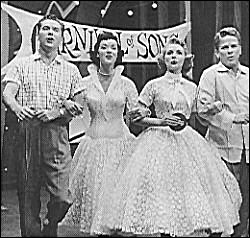
* Lucky Strikes' popular radio show Your Hit Parade debuts on TV. It stars clean-cut looking, very adult, white performers only, and it features the type of music (and performing styles) that white teenagers will very soon abandon wholesale -- light melodies, sweet lyrics and wholesome singers.
Hit Paraders: Russell Arms, Giselle McKenzie, Dorothy Collins, Snooky Lanson.
These innocent and inoffensive "feel-good" tunes reflect the mood of white middle class, suburban and small town America. Mona Lisa and The Tennessee Waltz are big hits this year, they are typical of white pop music. And they are Snoozeville, Daddy-o! Neither the producers nor the performers of the show were able to cope with the spirit and energy of rock 'n' roll; it became painful to watch and the show was put to sleep at the end of the 1959 season.
* The Mattachine Society (usually credited as the first gay civil rights organization) is founded in California. Harry Hay, its prime mover, is a former Communist. Uh-oh!
* The McCarran Internal Security Act is vetoed by President Truman, but is passed again - overriding the president's veto. The act contains draconian security measures aimed at the Communist threat, including a provision for the creation of detention camps "for emergency situations." The latter, perhaps inspired by the wholesale internment of Japanese-Americans in WWII, doesn't send shivers down many backs.
* Quatrefoil is published. James Barr's long novel is another landmark of gay fiction. In the closing decades of the 20th century it would be repeatedly lambasted by gay critics as being "accomodationist," and its author branded something like an Auntie Tom - all without regard to the era in which the novel appeared. That objection would soon be ironic as a good number of post-AIDS GLBT's make an about-face in the direction of emphasizing hetero-normative lifestyles and assimilation.
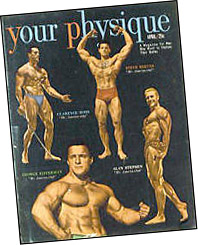 * And for the next four years I am getting it
on with other guys in school - no problem, except guilt, guilt, guilt! But
then masturbation stirred it up in equal amounts too. I begin buying,
with considerable self-consciousness, to put it mildly, magazines on
bodybuilding - Strength and Health and Joe Weider's
several publications.
* And for the next four years I am getting it
on with other guys in school - no problem, except guilt, guilt, guilt! But
then masturbation stirred it up in equal amounts too. I begin buying,
with considerable self-consciousness, to put it mildly, magazines on
bodybuilding - Strength and Health and Joe Weider's
several publications.
'58 issue of a Weider publication.
The appearance of the
pocket-sized beefcake
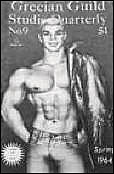 magazines
causes me to develop such furtive browsing techniques that I am lucky not to
have been arrested on suspicion of shoplifting, and to actually get these
items to the cash register and have the sale rung up unseen by anyone is an
agony that surely affirms the Catholic
notion of temporal punishment due to sin.
magazines
causes me to develop such furtive browsing techniques that I am lucky not to
have been arrested on suspicion of shoplifting, and to actually get these
items to the cash register and have the sale rung up unseen by anyone is an
agony that surely affirms the Catholic
notion of temporal punishment due to sin.
A popular beefcake magazine
1951
* HUAC begins a second wave of
hearings in the lower chamber of Congress, and Sen. Joseph McCarthy leads
the charge in the Senate. The
already overheated political climate degenerates into a three-year era of
grossly exaggerated charges and unfounded and unsubstantiated denunciations that
spread paranoia and hysteria throughout the nation. The word "McCarthyism" finds
its place in the American language as a result. Roy Cohn, a closeted gay
lawyer, is McCarthy's right-hand man and young Bobby Kennedy does his brief bit
for the Senator too.
* Julius and Ethel Rosenberg are convicted of spying for the Soviet Union and sentenced to death. The judge declares they are responsible for 40,000 dead Americans in the Korean War. The evidence against Mrs. Rosenberg is flimsy at best.
*
Production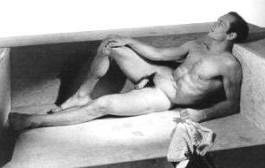 costs and ticket prices have yet to soar
through the roof, and the Fifties see a string of colorful Broadway musicals
with great songs. The King and I, starring Gertrude
Lawrence and Yul Brynner, opens on March 13.
costs and ticket prices have yet to soar
through the roof, and the Fifties see a string of colorful Broadway musicals
with great songs. The King and I, starring Gertrude
Lawrence and Yul Brynner, opens on March 13.
1942 nude of Brynner by gay photag, George Platt Lynes.
Set in the royal court in Bangkok in the 1860's, it has dazzling sets and costumes, and runs for 1,246 performances. The songs Hello, Young Lovers, Getting to Know You, Something Wonderful, and I Have Dreamed are covered by pop artists and find a place on the Hit Parade. The exotic looking, shaved-headed Brynner becomes a major star.
Julie Harris as Sally Bowles
 * I Am a Camera, a stage adaptation of gay English author Christopher Isherwood's
Berlin Stories opens on November 28th. It is written
and directed by another well-known gay English writer, John Van Druten, and
stars Julie Harris. Isherwood's stories, set at the dawning of the Nazi
era, will be reborn decades later as the hard and raucous Broadway musical Cabaret,
and later
made into a predictably wimpier Hollywood film.
* I Am a Camera, a stage adaptation of gay English author Christopher Isherwood's
Berlin Stories opens on November 28th. It is written
and directed by another well-known gay English writer, John Van Druten, and
stars Julie Harris. Isherwood's stories, set at the dawning of the Nazi
era, will be reborn decades later as the hard and raucous Broadway musical Cabaret,
and later
made into a predictably wimpier Hollywood film.
* One of Alfred Hitchcock's most esteemed films, the film noir classic Strangers on a Train, comes out in 1951, starring Robert Walker and bisexual actor Farley Granger. Based on the first novel of author, Patricia Highsmith (also bisexual), it brings her fame, especially in Europe.
*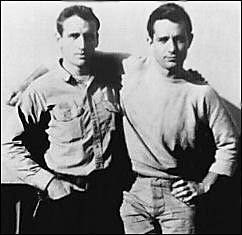 In his West 20th St. apartment in Manhattan the unknown Jack Kerouac bangs
out the manuscript of a novel on one long roll of paper in three weeks.
On the
Road is the thinly disguised adventures of his idol Neal Cassady (as the fictional
Dean Moriarty) and himself, and when the book is finally published in 1957 it
would signal the emergence of the Beat movement on the American scene.
In his West 20th St. apartment in Manhattan the unknown Jack Kerouac bangs
out the manuscript of a novel on one long roll of paper in three weeks.
On the
Road is the thinly disguised adventures of his idol Neal Cassady (as the fictional
Dean Moriarty) and himself, and when the book is finally published in 1957 it
would signal the emergence of the Beat movement on the American scene.
(right) Neal Cassady and Jack Kerouac
The general public assumes Kerouac himself to be the model for Dean Moriarty, but it was a role he was not suited for and a pose he cannot not sustain. The real-life Cassady outlasted the heyday of the Beats, and lived just long enough to streak across the Hippy firmament as one of Ken Kesey's Merry Pranksters, where he may be found in Tom Wolfe's The Electric Kool Aid Acid Test. Kerouac, however, suffered an inglorious fate: he became chronically morose and slid into heavy drinking, turning into a recluse -- and finally the willing prisoner of his rigidly conventional mother. He would die a thoroughly de-balled and domesticated creature, querulous and deeply conservative -- a monument to the power of straight.
1952
* War hero, Gen. Dwight
Eisenhower is elected President of the United States and serves for two terms.
He is a modest man, and one who finds the business of campaigning and
politicking distasteful. "I like Ike" is his campaign slogan - and it is hard
not to like Ike. Earnest, oftentimes worried-looking, clearly very much happier on
the golf course than at a press conference -- his genial, unassuming fatherly
image becomes a tranquilizer for Americans exhausted by the war and terrified of
the Red Menace.
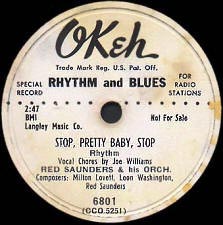
* "Jungle music" shows up.
Hot damn! Across
the country white teenagers within the broadcasting range of radio stations
playing what had been called "race music" until only a few years before,
embrace Rhythm and Blues as their own. The proprietor of the Dolphin
Record Store, one of the biggest
black-owned record stores in Los Angeles, reports that in one year his customers
have gone from zero whites to 40 percent white. Cleveland DJ Alan Freed
uses
the label "Rock and Roll" for the new (to whites) music, and his audience has gone from being
all black to heavily white. Although Freed later claimed to have coined the
term, "rock and roll" was a black slang expression for screwing, dating back to the
early 1920's. Most whites were initially unaware of that fact.
Straight-from-the-bottle "race music", rebranded Rhythm 'n' Blues, is
being tuned into white American
homes for the first time. And despite Freed's borrowed coinage, Rock 'n'
Roll was a slightly later fusion of black Rhythm 'n' Blues and white
country-western sounds,
which did not emerge nationally until
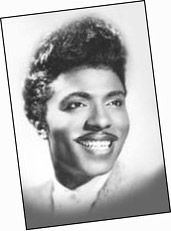 the mid-Fifties when Bill Haley and
the Comets showed up and Elvis Presley recorded "Heartbreak Hotel."
the mid-Fifties when Bill Haley and
the Comets showed up and Elvis Presley recorded "Heartbreak Hotel."
Little Richard: "Rhythm and blues had a baby and somebody named it rock and roll." (left.)
It doesn't matter what your
skin color is: no one's
parents are ready for
Little Richard (music.) One of the biggest shifts in American
popular music is underway - and it is one hell of a great time to be a
teenager!
* Popular yellow journalism writers, Jack Lait and Lee Mortimer inform
Americans in their latest book, U.S.A. Confidential, that juvenile
delinquency is linked "with
tom-toms and hot jive and ritualistic orgies of erotic dancing, weed-smoking and
mass mania, with African jungle background. Many music shops purvey dope;
assignations are made in them. White girls are recruited for colored
lovers....We know that many platter-spinners [DJ's] are hopheads. Many
others are Reds, left-wingers or hecklers of social convention....[teenagers]
frequent places the radio oracles plug, which is done with design...to hook juves [teenagers] and guarantee a new generation subservient to the Mafia.”
Wow! That's some kickass agenda, guys.
Another wild-eyed obsession of this pair is homosexuality; and when, a few
years, later Mortimer would focus his attention on queers it would have a direct impact on
my life.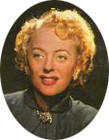
* The American Psychiatric Association adds homosexuality to its list of mental illnesses.
* Former U.S. soldier George Jorgensen, now Christine, achieves notoriety for her sex change done in Denmark.
Christine Jorgensen (right)
For many years her name will be used by comedians as an acceptable public allusion to anything referring to homosexuality. Instant laughs. Hyuk- hyuk. Jorgenson took most of the humor in stride and was quite tolerant of intrusive questioning...up to a point. However, years later when she was a guest of the The Dick Cavett Show. Cavett offended her by asking about the status of her private life with her "wife." She walked off the show, and as she was the only guest scheduled, Cavett had to fumble through the rest of the show talking about how he had not meant to offend her.
A Visit to Mary's
Early in the winter of '52 Donald Richie, who would later become famous as the leading Western authority on Japanese film and a Japanophile, is studying at Columbia Univeristy in NYC. He had spent his Army service in Japan and was asked to show a young visiting Japanese author, Yukio Mishima, around the town. His visitor's Confessions of a Mask was just being translated for an American edition. Included on
Detail of young Richie from cover of Japan JournalsMishima's list of things to do is a visit to a real gay bar, which he explained to Richie is because his half finished novel, Forbidden Colors, has several scenes in such places.
Richie, who is homosexual (he does not use the word "gay" as a personal preference), knew there were some in the Village, and with Mishima in tow they located Mary's on Eighth Street. Richie describes their visit:
"There we sat over our drinks and watched middle-aged men talk like women. [Based on my own visit in '59 this was an accurate description of the place.] This was something neither of us had expected and it was not very interesting.
"Nonetheless he gravely thanked me...."
(Summarized from The Japan Journals 1947 - 2004, Donald Richie)
1953
* President Eisenhower enthusiastically implements a policy which brands all homosexuals unfit for service in the Federal government and includes provisions for their arrest.
* The Korean War ends. The U.S. accepts a truce
as the solution to the war - the first major war in its history that the U.S.
has not won. It becomes the "forgotten war."
* The Rosenbergs are electrocuted at Sing Sing prison. Protests against the executions had been held in many places in the U.S. and around the world, and leading figures pleaded for mercy, including the Pope.
Mrs. Rosenberg (center) is escorted to the Death House.
The first 57-second jolt fails to kill Ethel, she is strapped back into the chair to receive two more jolts. After the Cold War ends it was discovered from Russian agents that she was not in their employ. Whoooooops.
* Jerome Robbins, a leading choreographer – and a
gay man, cooperates with HUAC in naming associates with supposed Communist sympathies or
connections.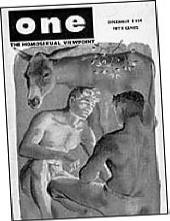
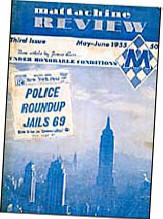
* Arthur Miller's play The Crucible, an indictment of witch hunting, opens at the Martin Beck Theater in New York City. It takes aim squarely at the boozy Sen. McCarthy's tactics of witch hunt hysteria.
A 1954 issue of One (left), and 1955 issue of Mattachine Review (right)
* One, a (non-beefcake) homophile magazine, begins publication.
* Los Angeles Mattachine Society dumps its members with past Communist links.
1954
* Brown v. Board of Education. In this watershed case the Supreme Court rules that school segregation is unconstitutional. While the decision does not contain a timetable for the desegregation of schools, nor does it ban other forms of segregation, there is no doubt in any quarter that finally the obligation for "Negro" equality had been laid squarely on the Federal government.
* Senator Lester Hunt commits suicide. He had been told
that Senator McCarthy intended to reveal that his son had been arrested in
Washington, DC on charges connected with homosexuality.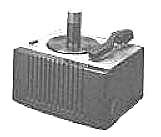
* The 45 rpm record player, which began as a small special unit which you attached to your radio in order to play the new size records has become the monster it was intended to be. It is now the industry standard - the old brittle 78 rpms are becoming history - and the player's small size, low price and portable models mean that teenagers can take their music with them.
In the era when the musical tastes of adults and teenagers are radically diverging, this little machine might lay claim to being the rocket which propelled the development of a youth market in music - with soft drinks, clothing and other products rapidly jumping on for the profitable ride. The Fifties were definitely the time when adolescents became firmly identified as a separate entity apart from adults - popularly portrayed and worried about as being in fierce opposition to family life and parental control.
* Steve Reeves stars in his first major film,
Athena, as Debbie Reynold's boyfriend
in a comedy spoof of physical culture and the California
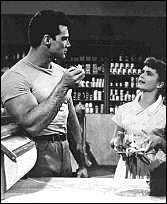 loony
fringe. Despite the snickering tone of the picture, Reeve's beautiful
physique and terrific good looks stimulate interest in bodybuilding.
loony
fringe. Despite the snickering tone of the picture, Reeve's beautiful
physique and terrific good looks stimulate interest in bodybuilding.
Steve Reeves and Debby Reynolds in Athena.
He attracts the attention of an Italian film maker who casts him in Hercules, the first of a new genre of sword & sandal epics starring American musclemen. Released in the U.S. in '59, Hercules would give an enormous amount of publicity to bodybuilding and initiate a huge boost in its popularity...and the rest is history, as they say. His film initiated a long string of "sword and sandal" epics starring bodybuilders, and he starred in a bunch of them. But Reeves himself was reputedly never at ease or cordial with the press, and as a real person he remained virtually unknown in the U.S. - unlike the later Arnold Schwarzenegger. However, he did have a successful career in Italy, including a spaghetti Western, and eventually retired with his wife to raise horses on a ranch in the American West.
* Sen. McCarthy begins hearings to prove that the
U.S. army has been infiltrated by Communists. With the help of President
Eisenhower and unedited footage of the hearings taken by newsman Ed Murrow the
army is exonerated and "McCarthyism" in all its squalid dishonesty is laid bare
to the public. McCarthy is censured by the Senate - only the third
time in its history that it has taken such a measure. Red-baiting dies
down, and the Senator dies in 1957 of the effects of years of alcoholism.
Marvin Eder (r) and Steve Reeves (l)
* This year I saw my first Broadway show when the national company of Kismet played in a nearby city. I went with my high school best friend, whom I had had sex with a few times and who shared my passion for muscle mags. The musical was bound to bowl me over - a bubbling, humorous tale set in long-ago Baghdad, sumptuous sets from an Arabian Nights fantasy and a talented cast singing songs derived from the most romantic works of Alexander Borodin.
However, it was the unexpected
sight of Steve Reeves and Marvin Eder - two bodybuilding "stars" of the era -
stripped to the waist, playing guards of the Wazir, that almost induced
cardiac arrest in my adolescent heart. Gulp! It was really, really true -
they do look like that in the flesh! Oh my gawd...
"THE HOUND'S AROUND"
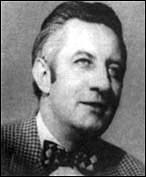
George "Hound Dog" Lorenz
In 1955 George "Hound Dog" Lorenz, a DJ who'd been playing R&B on a small daylight station, WJJL, in Niagara Falls, NY moves to 50,000 watt WKBW in Buffalo, and premiers live with Clyde McPhatter and Ruth Brown from the racially mixed Zanzibar Lounge. Lorenz was one of the first white DJ's to play what had until recently been called "race music" full time on his shows. At night his new station can sometimes be heard as far as Tennessee. I had been a religiously dedicated listener since his Niagara Falls days.
Alan Freed moves to WINS in New York City. R&B and rock and roll are twisting the tail of the pop music industry. It is difficult today to imagine the intensity with which teenagers responded to these first rock 'n' roll DJ's. Soon parents, schools, clergymen, politicians and the legion of self-appointed social commentators would be blaming them for every problem associated with young people.
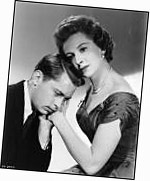
* Tea and Sympathy plays on Broadway (photo right). Supposedly on the daring subject of homosexuality, it is the story of a "sissy" student who is straightened out when the noble wife of a faculty member seduces him, thus proving to him (and the audience) that he is not a homo. The vaginal cure for male homosexuality is a popular straight myth of the era, though it does seem to de-eroticize the vagina by making it something akin to a genital poultice.
* I'm sixteen. I try heterosexual sex and have a steady girlfriend for the next four years. Except for lapses in my fantasies I don't have sex with guys. Look, everything else is changing! (Of the forty-five guys in my class I have had sex with four on a repeated basis. As adults one will marry but be an eager piece of trade, two will be gay and the other I lost track of completely. A fifth, whom I did not have sex with, will end up in jail after committing petty theft and running away with his boyfriend. Both were teenagers.)
* Swanson markets the first "TV Dinner." Americans buy 10,000,000 the first year!Just as the simple little flea brought the Black Death which wiped out millions in Europe's Middle Ages, this little frozen vermin led to the eventual annihilation of home cooking in the United States.
1955
* Mattachine Society of New York founded. Mattachine Review debuts in California.
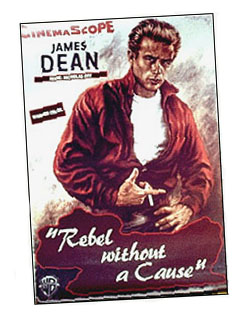
* Bisexual actor James Dean, a talented actor with stage and live TV drama credits, is brought to Hollywood after starring in a stage adaptation of Gide's novel, The Immoralist, a story with a homosexual theme.
James Dean in the famous red jacket.
Paperback cover of The Blackboard Jungle novel.
He explodes into stardom with Rebel Without a Cause and East of Eden. The former creates the image that millions of American teenagers identify with. His famous red jacket becomes a teenage trade mark.
* The Blackboard Jungle, a film about juvenile delinquency, based on Evan Hunter's shockingly vivid novel, features the song Rock Around the Clock by Bill Haley and the Comets. The song becomes a teenage anthem. The Bobbie Soxers have faded away and in their place is the secretive, clannish and sometimes sullen and disrespectful teenager. That word acquires such bad associations that there are even attempts by school authorities and others to force the use of various imbecilic labels in its place - dudes and dudettes, is one pair I recall.
'55 edition of Ripley & Alain Delon
* Patricia Highsmith's 1955 novel, The Talented Mr. Ripley, is made into a movie in France, and released in the U.S. in 1960 as Purple Noon. Highsmith said that its intense and handsome star, Alain Delon, was ideal as the sociopathic Ripley, and he went on to become a hugely talented international star. The French called him the "Ice-cold Angel," and his rough and tough past, coupled with criminal connections, a string of female partners and his bisexuality gave the nickname a good workout. A 1999 remake of Ripley starred Matt Damon, playing Tom Ripley as a more confused and likeable character...a rather gigantic step back from Highsmith's Ripley.
* The Third Avenue El, the last of
Manhattan's elevated trains, closes on May 12th. These trains had done
their own version of "shake, rattle and roll" at the level of third floor
windows up and down Ninth, Sixth and Third avenues for decades.
 They were
disliked for the incredible noise they made and for cutting off light to the streets
and apartments below, but at the same time riders loved them for the great views
and sense of almost amusement park-like fun as they sped along above the city
streets.
Most Americans had seen the Third Avenue El as several popular films had
featured it for atmospheric effect - The Lost Weekend (1945), Naked City
(1948) and On the Town (1949.)
They were
disliked for the incredible noise they made and for cutting off light to the streets
and apartments below, but at the same time riders loved them for the great views
and sense of almost amusement park-like fun as they sped along above the city
streets.
Most Americans had seen the Third Avenue El as several popular films had
featured it for atmospheric effect - The Lost Weekend (1945), Naked City
(1948) and On the Town (1949.)
The destruction of this last el opens up the rundown section of Manhattan's midtown east of Lexington Avenue to the sunlight and real estate developers. P. J. Clarkes, the old Irish bar used in the movie The Lost Weekend, turns into a celebrity watering hole and a fashionable drop-in spot. Very quickly this section of the Upper East Side becomes a trendy neighborhood, and is now considered part of the older posh "Silk Stocking District" which was really located closer to Fifth Avenue. As a cheap, affordable neighborhood it had acquired a noticeable gay male population, and Third Avenue - from the Sixties down to the Forties - will continue to be a busy cruising strip at night for a few more years.
* July 3rd Buffalo's WWOL DJ Guy King climbs
out a studio window with a mike to broadcast his show from the top of a
billboard overlooking Shelton Square. He exhorts his audience of teenagers
in the square below to honk their horns if they want to hear a repeat of the song he is playing.
The song was Bill Haley and the Comets' Rock Around the Clock.
Teenagers pile into their cars and descend into the area - the honking doesn't
stop, Rock Around the Clock doesn't stop and the result is holiday eve traffic
chaos. After two hours King is dragged off to jail for the stunt.
Several thousand teenagers have brought the downtown of America's fifteenth
largest city crunching to a halt. The Buffalo Evening News tucks
the story on the inside pages the next day, huffing about a "caterwauling
mob of children." But as radio-TV critic Gary Deeb has written, "the
News
blew the story, the editors failing to smell revolution when it broke wind right
in their face." Say, amen!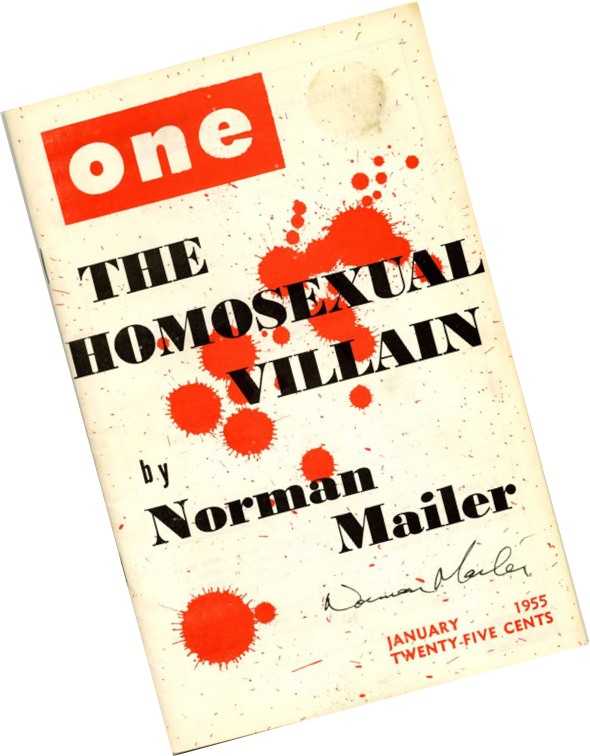
* Norman Mailer, maybe America's #1 male author of the era - and the most macho crotch-o of its literary world, wrote a major essay for the homosexual magazine One. It's like, he did WHAT!!! His piece was a long essay, "The Homosexual Villain," in which he examines his culturally typical knee-jerk reactions to homosexuality and essentially apologizes for how these have misshaped the two homosexual characters in his novels.
* Rosa Parks, a black woman, refuses to give up her seat on a segregated bus; Emmett Till, a black teenager, is kidnapped and bludgeoned to death after making a fresh remark or whistling at a white woman in Mississippi. Both events are benchmarks in the black civil rights struggle.
1956
*
Black singer Nat King Cole is
attacked onstage while performing in Birmingham, Alabama by four white men.
Nat Cole is the star of a national, prime time television show in 56 - 57.
It fails to attract major advertisers, and though NBC supports it without
significant advertising revenue and top-rated stars appear at nominal union fees
to bolster it, the show folds after one season. Advertisers are convinced
that they would suffer a significant loss of sales in the South by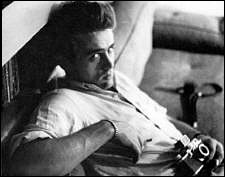 sponsoring
the show.
sponsoring
the show.
* James Dean is killed in a car crash just as his third film, Giant, is wrapping up. The senselessness of his death at the height of his fame is his apotheosis. He is a god for many white teenagers. God, man. As in G-O-D.
*
Elvis Presley, had begun his career in 1954 with That's All
Right, a cover version of a song by black, Delta blues singer, Arthur "Big Boy" Crudup.
And he honored Crudup with covers of another two of his songs.
(What Presley and other performers did not know was that Crudup did not receive his royalties,
which he was routinely screwed out of by white record producers, and this
led to his exit from recording.)
But in this year the white crossover singer, releases Heartbreak Hotel. His undulating hips - not to mention his unmentionably obvious dangling weenie and bouncing balls - would worry the nation. His career heralds a wave of rock 'n' roll "rockabilly" music. But his rapid domestication and conversion to a pop ballad singer paralleled the development of the far safer, saccharine genre of white-teen idol schlock rock. For a few years attempts to "whiten" pop music and put a racial cordon sanitaire around the pop record industry would ride this wave.
* Rock 'n' Roll is denounced as "a plot to mongrelize America." (woof! woof!) A White Citizens' Council spokesman in Alabama says, "We have set up a 20-man committee to do away with this vulgar, animalistic, nigger rock and roll bop." Even outside of the South its racially mixed teenage audiences upset parents and officials used to codes of customary, if not legislated, segregation R&R unabashedly celebrates the physical and hints at the sexual; and ridicules deferred gratification and the work obsession of the world of gray flannel suits. Congressmen rumble against it, parents hate it. But I am a slave to it. "Hail, hail Rock and Roll!"
* Year-end music industry statistics show that 68% of the music played by radio DJ's was rock 'n' roll recordings, two-thirds more than in the previous year. At the end of the following year every song on Billboard magazine's Top Ten would be a R&R one.
*
In the era before nudity was allowed and posing pouches were considered
suspicious gear, Bob Mizer, publisher of Physique Pictorial and owner of AMG beefcake photo business, found himself a constant focus of police attention,
and he even served jail time for his business activities. (In the U.K. John S.
Barrington had started a similar venture, and was in trouble with the law
there.) But what is less
known is that Mizer was a very feisty guy, who deeply resented the harassment which was
inflicted on all gay men, and he sometimes commented about this in the pages of
PP – a risky gesture for a gay man in the police spotlight. On the
cover of the Summer, 1956 issue of Physique Pictorial he writes:
"...IN MEMORIUM...
This issue of
Physique Pictorial is dedicated
to LEONARD CHAMBERS pictured here, who was SHOT AND KILLED by an off duty
POLICEMAN who was in private hire at the time! See page 3.
He continues on page 3 -- "WAS THE KILLING OF LEONARD CHAMBERS BY TWO OFF-DUTY POLICEMEN "JUSTIFIABLE HOMICIDE"? Acting in the employment of a private bail bondsman, two Southern California policemen forced Leonard Chambers to get in their private car for allegedly failing to appear on some traffic charges. They testified that Leonard pulled a gun on them even though they had previously searched him and had him handcuffed. In desparate [sic] "self-defense" they shot him twice in the back of the head. Leonard of course didn't live to tell his side of the story. The coroner's jurors dutifully declared this murder "justifiable homicide."
In this era the lives - and deaths - of "queers" and "homos", like those of "niggers," were matters of no importance in the world of nice straight, white Americans. A beat up queer didn't matter. A dead homo didn't matter. No marches, no protests, some lives didn't matter.
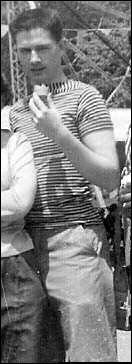 * It is 1956,
and I am eighteen. While having failed to attain the heights of disaster
reached by James Dean in Rebel Without a Cause, my adolescent
psyche, nevertheless, has ulcers. Most kids in this era have very little real
independence or privacy, however my parents are more controlling than most. And
they are seething with barely repressed anger - about almost everything.
"Talking things over" is never in their picture (even between
themselves); shouting
and threats are the language of "discipline," though to be truly fair,
not a few working
class families are in the same territory. Both parents have very set expectations of their only
surviving child -- unfortunately, often conflicting ones.
* It is 1956,
and I am eighteen. While having failed to attain the heights of disaster
reached by James Dean in Rebel Without a Cause, my adolescent
psyche, nevertheless, has ulcers. Most kids in this era have very little real
independence or privacy, however my parents are more controlling than most. And
they are seething with barely repressed anger - about almost everything.
"Talking things over" is never in their picture (even between
themselves); shouting
and threats are the language of "discipline," though to be truly fair,
not a few working
class families are in the same territory. Both parents have very set expectations of their only
surviving child -- unfortunately, often conflicting ones.
If you can't play baseball, you can't make it as a boy.
Jules Pfeiffer, Fifties cartoonist
Me, June '56
In any case, Yours Truly, a "nice kid" - an intelligent, polite, hard-working student in the world of adults - has become something else in his own world. Painfully self-conscious about being too good a student and a failure at anything athletic I have competed in other ways: smoking and drinking since junior high school, regularly sneaking to bars that serve minors for three years, and probably having more sex in the past six years than many adults. In the process I have become such a smooth liar and habitual pretender that the punishments I receive are almost always for petty infractions of my curfew. When at home I retreat to my bedroom, listening to old Bessie Smith songs recently re-released on LP's or trying to make it through Joyce's Ulysses; at night I toss and turn unable to sleep, torn between my desire to be free and a deep-down fear of being too inadequate to cope beyond my small town. And those magazines are still hidden on the top shelf of my closet, sitting there like a silent reproach.
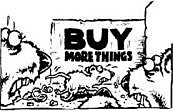
By the mid-Fifties the winds of change are picking up force throughout U.S. society.
The proliferation of new products for home and personal use is making consumerism the new American Way of life, automation is changing manufacturing and threatening the blue collar worker's job, and for white collar workers there is now the "Rat Race."
Those "gosh" and "gee whiz" types called Bobbie Soxers have vanished, and parents are wondering if their prickly Teenager, who uses that irritating word "daddy-o," could possibly end up like one of those adolescent catastrophes in Rebel Without a Cause. There is now something called the Generation Gap to worry about, not to mention juvenile delinquency and Rock and Roll riots -- and somebody said they're finding used "rubbers" in the bushes around the football field! This generation of adolescents with its regular supply of spending money and the development of a separate segment of the recording industry aimed at it is the beginning of the "youth market," which will in not too many decades become a major part of America's consumer economy.
The first five years of the decade saw live TV dramas, such as Armstrong Circle Theatre, Westinghouse Studio One and Kraft TV Theatre among others, and have featured original works by the likes of Paddy Chayevsky and Gore Vidal (quietly making a living doing TV scripts after being skunked over The City and the Pillar), and the acting talents of Rod Steiger, Geraldine Page, Paul Newman, James Dean, Steve McQueen, Susan Strassberg, etc. At the mid-Fifties taping and the move to Hollywood brought an end to this era of creativity. The sugar-coated sit-com would reign unchallenged, a reassuring world in which Communists, blacks and sex are were almost never acknowledged.
The Fifties is the golden era of the Hollywood musical. And there is a
crop of new faces in Tinseltown, including Marilyn Monroe and several closeted gay leading men - Tab Hunter (right), Rock Hudson, George Nader, Dirk Bogarde et al. The film Man in the Gray Flannel Suit tries to explore the new world of materialism, conformity and the furious competitiveness of the white collar world. By the midpoint of the decade Marty, The Rose Tattoo, On the Waterfront, From Here to Eternity, The Country Girl, The African Queen and A Streetcar Named Desire have been filmed.
The question, "What are you?" is still immediately understood by many Americans as an inquiry about their "nationality" (i.e., ethnicity) and/or religion. Large numbers of Americans whose parents or grandparents were immigrants from Europe continue to identify themselves as "Polish" or "Italian," etc. Even Irish-Americans whose foreign roots are often with their 19th century grandparents and great-grandparents usually call themselves "Irish." Although this dual identity is most common among working class Catholics, in some areas of the Midwest it is found among people of north European Protestant origins. In the post-WW II era Jews have finally made it in American public life, and while many of the characteristics of East European Jewish culture are rapidly fading, Jews maintain a very strong sense of a unique identity. The battle for racial equality has begun in earnest - black civil rights protests and marches, a resurgent Ku Klux Klan, violent mobs of white segregationists are in the news, and would stay there for the remainder of the Fifties and through the Sixties.
Rock and Roll not only changes the sound of pop music, it is changing its color. No matter how many cover recordings by the likes of Pat Boone and Georgia Gibb are produced, rock and roll is still in large measure black territory for many of its young fans. But in 1957 American Bandstand from Philadelphia with Dick Clark would go national on TV - it will feature a squeaky clean, overwhelmingly white group of on-camera teenagers; and while initially featuring many black performers, it will rapidly become a major promotional vehicle for white teen idol pop music. In the same year, Allan Freed's one-week old ABC-TV Big Beat dance show will be cancelled when black teenage singer Frankie Lyman dances with a white girl on camera (and this is in New York City, not Alabama.)
Despite the post-war deluge of war memoirs and a never-ending series of books by Winston Churchill, as well as sentimental popular fiction, novels with probing themes sell well too - Catcher in the Rye, Too Late the Phalarope, The Caine Mutiny, The Adventures of Augie March, Man with the Golden Arm, The Invisible Man.
Gay life is furtive, almost all gay people try to pass as straight. Gay "underground" rather than gay subculture has been reasonably used to characterize gay and lesbian life of these years. Too much visibility even in private life, as at the Artists and Models Ball in NYC, brings down the police and gets your photo in the newspaper with a consequent loss of employment and public disgrace for the homo and his family.
And that's in Little Old New York, folks!
Nevertheless, for most gay people most of the time and in the decades to come, gay life will be a life first, not a cause nor an organization.
Now, however, it is only the fall of 1956, and I am just entering college.
mail to: nycnotkansas@gmail.com
CONTENT-RELATED LINKS - checked December 2019
(Each section of the site has its own links)
Senator Joseph McCarthy - bio of alcoholic demagogue of Red Scare fame.
HUAC, general info - excellent overview of the role of HUAC in American life and politics.
Congressional Record
- gays in the government worries
Lavender
Scare - Fag-hunting in the guise of anti-Communism, interview with author,
David K. Johnson
Charles Jackson
- interesting blog entry on Fall of Valor, quoting comments by
Richard Amory, author of Song of the Loon.
History of Rock
-
many great insights, and more than what its title says; an
extremely well written, well thought out site.
George Lorenz, "The Hound Dog"
-
one of the original popularizers of R&B among white adolescents
Alan Freed
- another famous and controversial DJ who pioneered Rock n Roll
(be warned - small type ahead)
The Chitlin' Circuit and the Road to Rock 'n' Roll - the
musical and commercial roots of an African-American institution at the source of 20th century
American pop music.
Lon of New York
- excellent article on famous 50's
photographer of bodybuilders and homoerotica
Bob Mizer and AMG -
a commercial site dedicated to the work of first post-WW II photographer & publisher
of homoerotica.
Third Ave.
El - short, impressionist film of the
famous Third Avenue El in the 1950's, definitely worth a look.
glbtq
archives
- encyclopedic gay site, lots of material on pre-Sixties
Gay New York
- George Chauncey's highly regarded history of gay NYC from early
1900's to just after WW II.
Journey to an Overlooked Past -
a journey through gay New York
1900 to 1948.
The Evening Crowd at Kirmser's
- (non fiction book) - Wonderful gay memoir
from the end of WW II in St.Paul, MN. Highly recommended.
Sex Panic - (non-fiction) journey into the paranoid
heart of a Fifties gay witch hunt
Boys of Boise - (non-fiction book)
another account of 50's gay witch hunt
GENERAL INTEREST LINKS
Recordings and books available from Amazon.com and other sources:
Charlie Parker
- Bongo Bop
Frank Driggs Collection
- article on famous jazz collection
Little Richard - Tutti Frutti